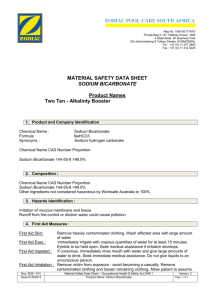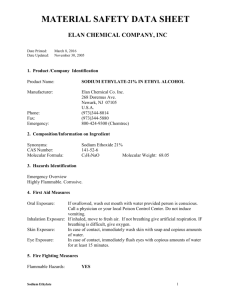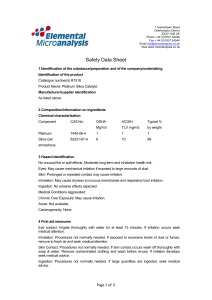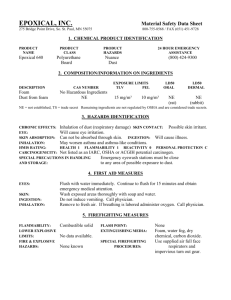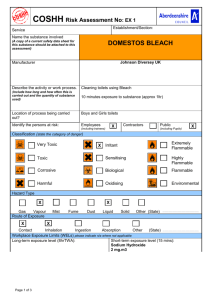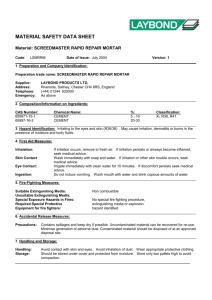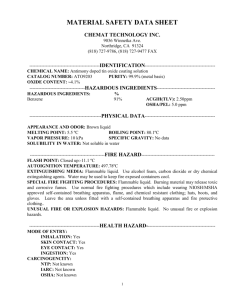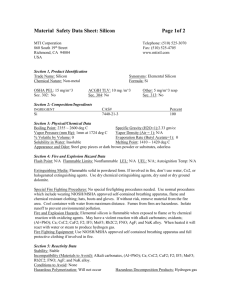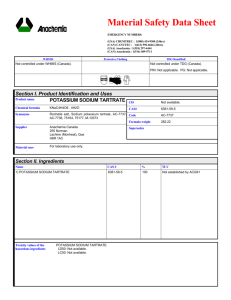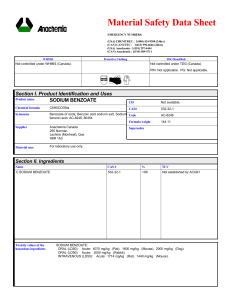Sodium Bicarbonate
advertisement
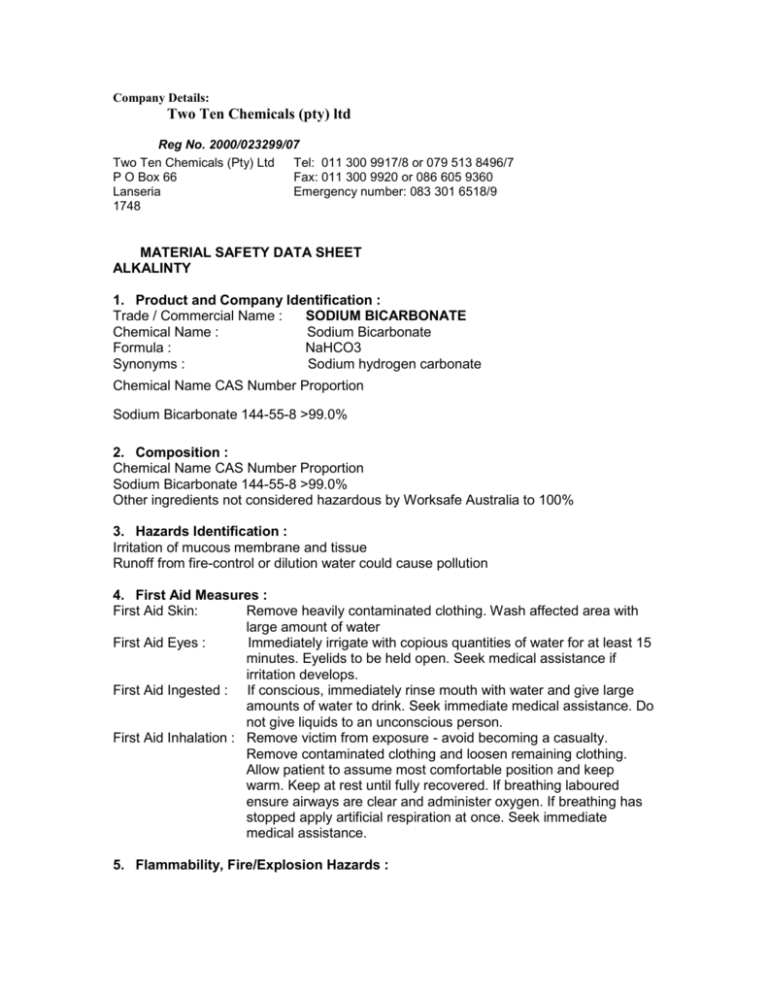
Company Details: Two Ten Chemicals (pty) ltd Reg No. 2000/023299/07 Two Ten Chemicals (Pty) Ltd Tel: 011 300 9917/8 or 079 513 8496/7 P O Box 66 Fax: 011 300 9920 or 086 605 9360 Lanseria Emergency number: 083 301 6518/9 1748 MATERIAL SAFETY DATA SHEET ALKALINTY 1. Product and Company Identification : Trade / Commercial Name : SODIUM BICARBONATE Chemical Name : Sodium Bicarbonate Formula : NaHCO3 Synonyms : Sodium hydrogen carbonate Chemical Name CAS Number Proportion Sodium Bicarbonate 144-55-8 >99.0% 2. Composition : Chemical Name CAS Number Proportion Sodium Bicarbonate 144-55-8 >99.0% Other ingredients not considered hazardous by Worksafe Australia to 100% 3. Hazards Identification : Irritation of mucous membrane and tissue Runoff from fire-control or dilution water could cause pollution 4. First Aid Measures : First Aid Skin: Remove heavily contaminated clothing. Wash affected area with large amount of water First Aid Eyes : Immediately irrigate with copious quantities of water for at least 15 minutes. Eyelids to be held open. Seek medical assistance if irritation develops. First Aid Ingested : If conscious, immediately rinse mouth with water and give large amounts of water to drink. Seek immediate medical assistance. Do not give liquids to an unconscious person. First Aid Inhalation : Remove victim from exposure - avoid becoming a casualty. Remove contaminated clothing and loosen remaining clothing. Allow patient to assume most comfortable position and keep warm. Keep at rest until fully recovered. If breathing laboured ensure airways are clear and administer oxygen. If breathing has stopped apply artificial respiration at once. Seek immediate medical assistance. 5. Flammability, Fire/Explosion Hazards : Not flammable. Non Combustible material. Will decompose in a fire evolving carbon dioxide and form sodium carbonate which is a respiratory, skin and eye irritant. EXTINGUISHING MEDIA: Use extinguishing media appropriate for surrounding fire. Fire fighters to wear self-contained breathing apparatus and full protective clothing when fighting fire. 6. Accidental Release Measures : Wear proper protective equipment. Ventilate area. Respiratory protection is required in dusty environment. Sweep up spill but avoid generating dust. Vacuuming or wet sweeping may be used to avoid dust dispersal. With a clean shovel, transfer spilled material into clean-labeled containers for disposal. 7. Handling and Storage Recommended : Remove from Organic Peroxides Poison Corrosives Storage in the same room or space is prohibited with the following classes : The rooms or spaces should be at least 10M apart. Explosives Flammable Gases Poisonous Gases Flammable Liquids Flammable Solids Spontaneously Combustibles Dangerous When Wet Radioactive 8. Exposure Controls / Personal Protection No value assigned by the National Occupational Health and Safety Commission (Worksafe Australia). Nuisance dust of 10mg/m3 (TWA) should be observed. Avoid skin and eye contact and inhalation of dust. Wear overalls, safety glasses or goggles and impervious (rubber) gloves. Respiratory protection is required if dust levels are high (>10mg/m3). An approved dust/mist respirator meeting Australian Standard 1716 should be worn in dusty environment. Always wash hands before smoking, eating, drinking or using the toilet. 9. Physical and Chemical Properties : Appearance, odour : White crystalline solid, odourless Melting Point : Starts to decompose at 70°C Boiling Point : No data available Vapour Pressure (20°C) : No data available Vapour Density : No data available Specific Gravity (20°C) : 2.159 compressed solid. 1.0 for granular form (bulk density) Flash Point (Open Cup) : No data available Explosion Limits : No data available Solubility in Water : 96g/L (20°C) 10. Stability and Reactivity pH (10g/L solution) : Solubility : Molecular Formula : Stability and Reactivity : 8.4 Soluble in water. Insoluble in alcohol. NaHCO3 Stable under normal temperatures and pressures. Decomposes with heat to release carbon dioxide. Reacts with acids to release carbon dioxide. 11. Toxicological Information Oral LD50(rat): 4220mg/kg 12. Ecological Information No data available 13. Disposal Considerations Disposal in accordance with federal, state or local regulations. Disposal Method Packaging : Disposal in accordance with local legal provisions. 14. Transport Information Not classified as a dangerous Good by the Australian Code for the Transport of Dangerous Goods by Road and Rail. Store in a cool, dry, well ventilated place. Keep containers tightly closed. Isolate from acids and heat. 15. Regulatory Information EEC Hazard Classification : Not regulated Risk Phases : Harmful by inhalation and if swallowed Safety Phases : Avoid contact with eyes National Legislation : Not regulated 16. Other Information Reason for Alteration : General update. The data in this material safety data sheet relates only to the specific material designated there in and does not relate to use in combination with any other material in any process. The information set forth herein is furnished free of charge and is based on technical data that Two Ten Chemicals believes to be reliable. It is intended for use by persons having technical skill and at their own discretion and risk. Since conditions of use are outside our control, we make no warranties, express or implied, and assume no liability in connection with any use of this information. Nothing herein is to be taken as a license to operate under or a recommendation to infringe any patents. Date of revision: 3 March 2004
